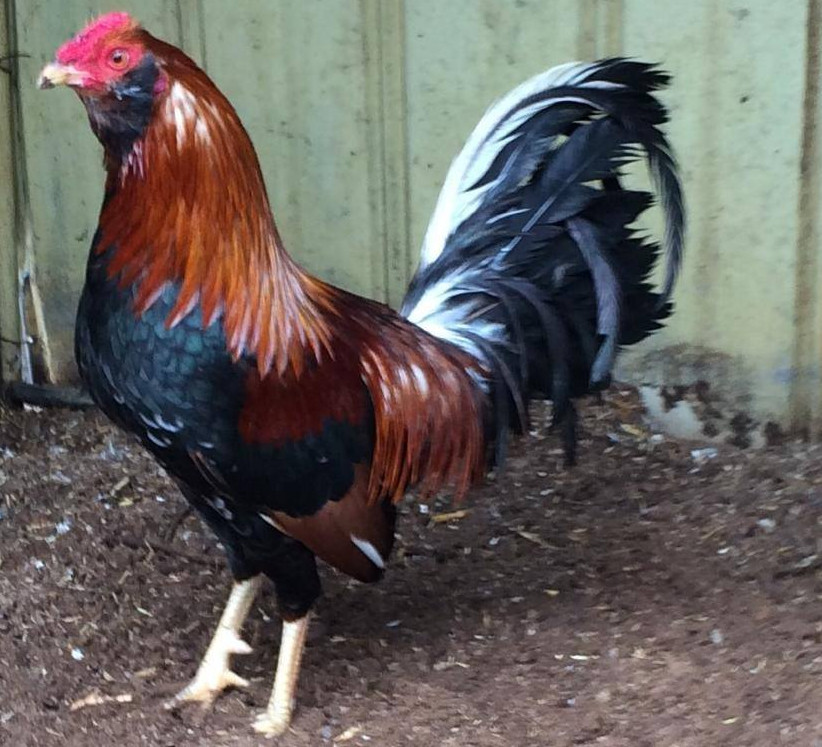Muff Gamefowl, a breed known for its distinctive appearance and impressive fighting abilities, has a rich history that dates back several centuries. This article explores the origin and background of Muff roosters, their physical characteristics, behavior, fighting style, notable breeders, and their rarity in the poultry world.
Muff Gamefowl History and Origin
The history of Muff roosters can be traced back to the early days of cockfighting in England and Ireland. These birds were originally bred for their tenacity, strength, and fighting spirit. The breed is believed to have originated from crosses between English Gamefowl and Irish Gamefowl, resulting in the development of a new and distinct breed known as the Muff Gamefowl.

Physical Characteristics
Muff Gamefowl are medium-sized birds with a muscular build and an alert, upright stance. They have a strong, broad chest, well-developed wings, and powerful legs. One of the most recognizable features of Muff roosters is their distinctive head shape, characterized by a prominent muff and beard. The muff refers to the feathering around the face and throat area, while the beard is the tuft of feathers below the beak.
In terms of color, Muff exhibits a wide range of variations. They can be found in shades of red, brown, black, and even rare colors like spangled or wheaten. These vibrant plumage colors, combined with their unique head feathering, make Muff roosters visually striking and highly sought after by poultry enthusiasts.
Behavior, Aggressiveness, and Fighting Style
Muff Gamefowl are known for their feisty and aggressive temperament, which is highly valued in the cockfighting world. They possess a strong fighting spirit, quick reflexes, and impressive agility. Their natural aggression is channeled into their fighting style, which typically involves aggressive rushing and slashing attacks.
Regarding cockfighting, Muff roosters are highly esteemed for their ability to deliver powerful strikes and withstand intense battles. They are known for their endurance, resilience, and unwavering determination in the face of formidable opponents. These qualities, combined with their physical attributes, make Muff Gamefowl formidable opponents in the cockfighting arena.
Notable Muff Gamefowl Breeders
In the United States, several notable breeders have made significant contributions to preserving and improving the Muff rooster breed. These breeders include Johnny Jumper, Carol Nesmith, and Richard Kelly. Their dedication and expertise in breeding Muff Gamefowl have helped maintain the breed’s purity and quality.
Muff roosters have gained immense popularity in the Philippines and are bred by numerous dedicated enthusiasts and breeders. Notable breeders in the Philippines include Biboy Enriquez, Patrick Antonio, and Boyet Legazpi, who have established a strong reputation for their Muff Gamefowl strains.
Is Muff Gamefowl Rare?
While Muff Gamefowl may not be as common as some other gamefowl breeds, they can still be found in certain poultry circles and breeding communities. Due to their unique physical characteristics, fighting abilities, and historical significance, Muff roosters are highly regarded by enthusiasts and collectors. However, their rarity adds to their allure and makes them a prized possession for those who appreciate their distinct qualities.
Conclusion
Muff Gamefowl, with their rich history, unique appearance, aggressive temperament, and impressive fighting style, is a breed that has captivated poultry enthusiasts for generations. Their distinct head feathering, muscular build, and vibrant plumage make them instantly recognizable. Whether in the cockfighting arena or admired for their beauty in exhibitions, Muff Gamefowl continues to leave a lasting impact. With the dedication of notable breeders and the appreciation of enthusiasts, the legacy of the Muff rooster is sure to endure, ensuring that this classic breed remains a cherished part of the poultry world.
See Also:
- Miniature Gamefowls: The Petite Powerhouses of the Exhibition Arena
- Kelso Grey Gamefowl: A Legendary Crossbreed with Exemplary Traits
- Irish Whitehackle Gamefowl: A Powerful Crossbreed with Rich Heritage
- Shamo Gamefowl Bloodline History and Fighting Style
- Regular Grey Gamefowl Bloodline Characteristics and Fighting Style
